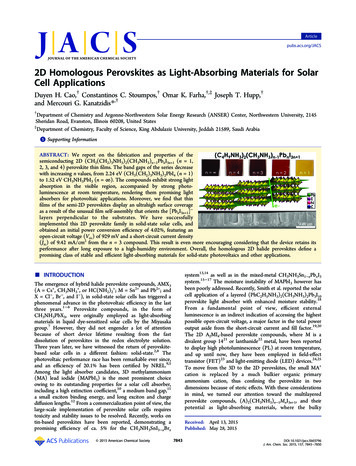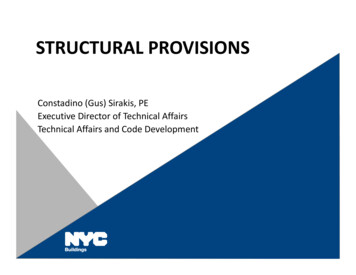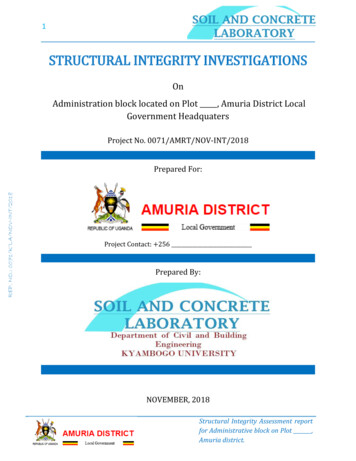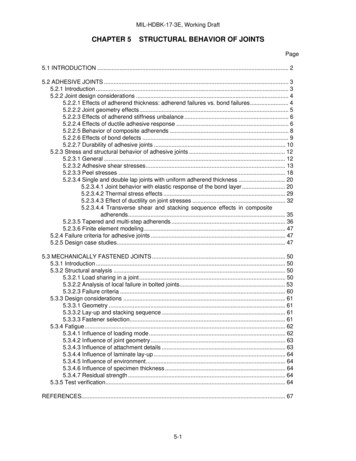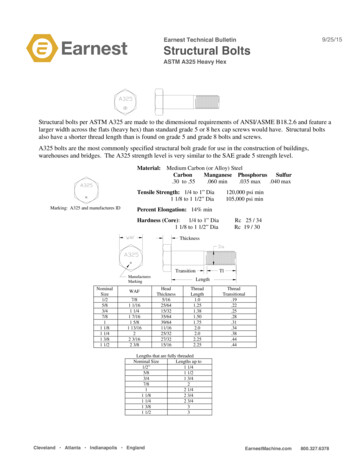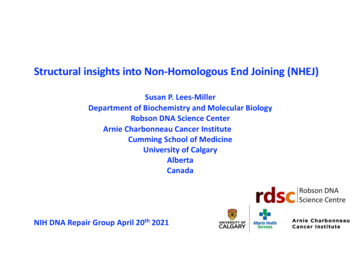
Transcription
Structural insights into Non-Homologous End Joining (NHEJ)Susan P. Lees-MillerDepartment of Biochemistry and Molecular BiologyRobson DNA Science CenterArnie Charbonneau Cancer InstituteCumming School of MedicineUniversity of CalgaryAlbertaCanadaNIH DNA Repair Group April 20th 2021
Phosphatidyl inositol 3-kinase-like protein kinases PIKKsDNA-PKcsATMATRDNA-dependent protein kinase catalytic subunit (PRKDC)Ataxia-Telangiectasia MutatedATM and Rad3-relatedATMATRDNA-PKcsSerine/threonine protein kinasesActivated in response to DNA damagePhosphorylate substrates on SQ/TQ and other motifsFrom: Blackford and Jackson, Molecular Cell, 2017
Cellular response to IR-induced DNA double strand breaks (DSBs)Other DSB inducing agent Some chemotherapeutics Endogenous processesIonizing Radiation Radiation Therapy Radiation ExposureG2ResectionKu70/80MRNCtIP, Exo1,Dna2DNA-PKcsATRATMATRIPNon-homologousEnd Joining(NHEJ)DDR signalingCell cycle ation forksS phaseYXLF, XRCC4,DNA ligase 4ArtemisRPA
1985- Human cells contain a DNA-activated protein kinaseWalker et al, EMBO J 4(1) 139-145 (1985)- DNA- Hsp90Carl W. Anderson Ph.DBrookhaven NationalLaboratory, NY
1989Identification of DNA-PK phosphorylation sites inHsp90PEETQTQFirst example of SQ/TQ motif for PIKK1990Preliminary purification and characterization ofDNA-PKcs (p350) and co-purification with Ku
Simultaneous discovery of DNA-PKcsTim Carter, William Dynan, Steve Jackson
The Phosphatidyl Inositol 3-kinase-like family of serine/threonine protein kinases, PIKKs1995
Carl W. Anderson Ph.DBAPhDPDF19752011Harvard 1966Washington University 1970Cold Spring Harbour 1971-1974Biology Department, Brookhaven National Laboratory, NYChair, 1999-2011Senior Scientist EmeritusVisiting scientist at National Institute of Environmental HealthSciences (NIEHS), NCResearch interests: Poliovirus genome Discovery of DNA-PK, early work on DNA-PK purification,phosphorylation, and cloning. Post-translational modification of p53 with Ettore Appella NIH. Founded the International Association for Protein Structure Analysisand ProteomicsOctober 21 2020Age 76
Mechanism of Non-Homologous End Joining (NHEJ): Major pathway for repair of IRinduced DSBs in human cells Required for V(D)J recombination inadaptive immune systemG2Resection Active in G0, G1, G2Ku70/80 Error proneXLF, XRCC4,DNA ligase 4ArtemisMRNCtIP, Exo1,Dna2DNA-PKcsATRATMATRIPNon-homologousEnd Joining (NHEJ)DDR signalingCell cycle ation forksS phaseY Rapid repairRPA
DNA-PKcs and Ku70/80 assemble on ends of dsDNA to form DNA-PK Ku binds with high affinity to ends ofdsDNA In the presence of DNA-PKcs, Kutranslocates inwards so that DNAPKcs now occupies the extreme endsof the DNA (Yoo and Dynan, NAR, 1999) DNA-PKcs plus Ku assembled ondsDNA DNA-PKKu70/80Ku70/80Ku70/80DNA-PKcsActiveprotein kinase
Autophosphorylation of DNA-PK results in disruption of the Ku-DNA-PKcscomplex and loss of activityPPNPAMATP p-DNA-PKcsPre-incubation with ATPresults in loss of DNA-PKactivity Autophosphorylation of purifiedDNA-PKcs, Ku70 and Ku80Autophosphorylationdisrupts the interaction ofDNA-PKcs and Ku AMP-PNP- ATPp-Ku80p-Ku70 ATPPurified: DNA-PKcs, Ku70/80IP:Ku70/80WB:DNA-PKcs and KuChan and Lees-Miller, JBC, 1996
Identification of DNA-PKcs autophosphorylation sites1892N-HEATABCDE and S3205T26092056 and PQRT3950PQRS2056PM-HEATDouglas et al, BJ, 2002Chan et al, G&D, 2002Cui et al MCB 2005; Chen et al, JBC, 2005Douglas et al, MCB, TT3950PKIN35804100FATC4128
Autophosphorylation of ABCDE and PQR phosphorylation sites are important for DSBrepair and VDJ 00FATC4128 DNA-PKcs- DNA-PKcsDNA-PKcs null cells re-expressing DNAPKcs-ABCDE A are more sensitive to IRthan cells lacking DNA-PKcs- ABCDE AKathy MeekMichigan State UniversityDing et al, MCB 2003
Model for assembly of Ku and DNA-PKcson dsDNA endsKu70/80 Ku binds DSBKu70/80DNA-PKcs Recruits DNA-PKcs Assembly of a synaptic complex on bothends of the DSB (active DNA-PK) Autophosphorylation of DNA-PKcs (intrans?) Dissociation of csKu70/80PPDNAPKcsPKu70/80
Ablation of ABCDE sites impairs release of DNA-PKcs from DNA-bound Ku in vitrominPurified DNA-PKcs and KudsDNA-Biotin streptavidin-bead pull down assaysWestern blot DNA-PKcs and KuHammel et al, J. Biol. Chem. 2010Jette et al, Prog. Biophys. Mol. Biol. 2015
In vivo evidence for autophosphorylation induced dissociation of DNA-PKcs from DSBsUV laser microbeam irradiation - GFP-DNA-PKcsWt-DNA-PKcs rapidly dissociates fromUV laser induced DNA damagePhosphorylation defective(ABCDE: T to A)and kinase deadare retainedUematsu et al, J Cell Biol. 2007 (David Chen)
Model for assembly and autophosphorylation induce disassembly of the DNA-PK complexin the initial stages of NHEJ:P KuP DNA-PKcsPPDissociation ofphosphorylatedDNA-PKcsP DNA-PKSynapsis(tethering of DNAends nal change
Model for NHEJ incorporating detection of DSB by Ku, recruitment and autophosphorylation ofDNA-PKcs, removal of non-ligatable end-groups and ligation1. IR induces DSBs withnon-ligatible end groups Ku* *2. Detection of DSB3. Tethering of DSB ends Autophosphorylation ofDNA-PKcs Processing (removal ofnon-ligatable end-groupsproduced by IR)1. DSB detectionand tethering:Ku, DNA-PKcs3. Ligation:XRCC4, DNAligase IV, XLF**PNKP DNA-PKcs2. End Processing:QuickTime and adecompressorare needed to see this picture.Removal of IR-inducednon-ligatable end groups *P PLigation of DSB endsP PP PP PDNA-PK Removal of sociation of autophosphorylatedDNA-PKcs
Model for NHEJ incorporating detection of DSB by Ku, recruitment and autophosphorylation ofDNA-PKcs, removal of non-ligatable end-groups and ligationOrder of events?* * Ku3. Ligation:1. DSB detectionand tethering:XRCC4, DNAligase IV, XLFKu, DNA-PKcsOrder of recruitment?Artemis interacts withDNA-PKcs and DNAligase IV. How/when isArtemis recruited?PNKP interacts withXRCC4. When is XRCC4recruited? When doesprocessing occur?**ArtemisPNKP? DNA-PKcs?2. End Processing:QuickTime and adecompressorare needed to see this picture.Artemis, PNKP, Pol mu/pol lambdaMre11? Tdp1? WRN1?P PP PP PP tion of autophosphorylatedDNA-PKcs
Assembly of a molecular machineDetection, tethering, end-processing and ligation all occur within one dynamic molecular assemblyDSB ends always enclosed within assembly, hand-off from one stage to anotherDetectionProcessingLigation and releasePP DNA-PKcs phosphorylationP ATM phosphorylationPCK2 phosphorylationAdapted from Williams et al, DNA Repair, 2014Yano and Chen, Cell Cycle 2008John TainerLBNL/MD Anderson
How does the NHEJ machinery assembleand carry out NHEJ?APLFLINP1 How does the XLF-XRCC4-DNA ligase IV complexinteract with the Ku-DSB-DNA-PKcs complex? How does Artemis interact with DNA-PKcs andDNA ligase IV?DNALigase IV How do PAXX, APLF and LINP1 stabilize thesynaptic complex?Hammel et al, JBC, 2016Brosey et al, Methods Enzymol, 2017Wang et al, Nature Struc. Mol. Biol. 2018Thapar et al, NAR 2020XLFXRCC4
Structures of NHEJ componentsStructure of the Ku70/80 heterodimer,core DNA binding domainKU80 contains a flexible C-terminal “tail” thatinteracts with DNA-PKcsRed KU70Yellow KU80Grey dsDNAWalker et al, Nature 2001Hammel et al, JBC, 2010Gell and Jackson, NAR, 1999Harris et al, J. Mol. Biol. 2004
Structures of DNA-PKcs and DNA-PKcs-Ku-dsDNA ibanda et al, Nature, 2010Sharif et al, PNAS, 2017Chen et al, Molec Cell, 2021Chaplin et al, Nat. Struc.Molec. Biol. 2021Sibanda et al, Science, 2017ABCDET2609, S2612T2620, T2638S3205T2647 2801PFAT3580T3950P 4100KINFATC4128Yin et al, Cell Reports, 2017
Structures of NHEJ componentsXRCC4Minus C terminal tailJunop et al, EMBO J, 2000Sibanda et al, NSMB, 2001Wu et al, MCB, 2009Andres et al, Mol. Cell, 2007XLF (XRCC4-like factor)Minus C terminal tailXRCC4 (truncated, blue) and XLF(truncated, magenta) interact viatheir head domainsMichal HammelHammel et al, JBC, 2011
Models for how the NHEJ proteins may interact at DSBs based on individual structuresFrom Frit et al, 2019Hammel et al, JBC, 2011, 2016Frit et al, Prog Biophys Mol Biol. 2019Liang et al, Prog Biophys Mol Biol. 2020Graham et al, Molec. Cell 2016
Challenges with understanding the function of DNA-PKcsIts BIG4128 amino acids180 x 130 x 1051892N-HEATSibanda et al, Science, PPP2801S3205PFATT3950PKIN35804100FATC4128
What’s the difference between these model organisms?Contain DNA-PKcs/PRKDCNo DNA-PKcs/PRKDC“DNA-PKcs is a vertebrate-specific PIKK”HumanDrosophila melanogasterMouseDanio rerio (Zebrafish)S. pombeArabidopsis thalianaCaenorhabditis elegansS. cerevisiae
DNA-PKcs is highly conserved in vertebrateslcl Query 10001lcl Query 10002lcl Query 10003lcl Query 10001lcl Query 10004lcl Query 10002lcl Query 10005lcl Query 10003lcl Query 10006lcl Query 10004lcl Query 10007lcl Query 10005lcl Query 10008lcl Query 10006lcl Query 10009lcl Query 10007lcl Query 10010lcl Query 10008lcl Query 10011lcl Query 10009lcl Query 10012lcl Query 10010lcl Query 10013lcl Query 10011lcl Query 10014lcl Query 10012lcl Query 10015lcl Query 10013lcl Query 10016lcl Query 10014lcl Query 10017lcl Query 10015lcl Query 10018lcl Query TORMILIIGARBAMBOOlcl Query 10017lcl Query 10018ALLIGATORGARCOBALTLees-Miller et al, Prog. Biophys. Mol. Biol. 2020Red highly conservedBlue less conservedGrey no conservation
DNA-PKcs is highly conserved from human to sponge(metazoa/vertebrates/invertebrates)COBALTRed highly conservedBlue less conservedGrey no conservationLanceletAnnelid wormScorpionPolychaeteAlvinella pompejanaSea urchinTrichoplaxPlacazoaCoralLees-Miller et al, Prog. Biophys. Mol. Biol. 2020***
Weak amino acid similarity between DNA-PKcs and other PIKKsAmino acid identitybetween DNA-PKcsATM, ATR and mTORFrom Clustal OmegaDNA-PKcsHuman: 100%Mouse: 80%Xenopus 64%Danio58%ATMATRmTOR 18% 17% 16%COBALTRed highly conservedBlue less conservedGrey no conservation
DNA-PKcs conservation in representatives from all major phylaCOBALT Red highly conservedBlue less conservedGrey no conservationRotiferBrachionus plicatilisPlantMossPhyscomitrella patensNematodeRoundwormTrichinella pseudospiralisOomyceteLeaf moldPlasmopara halstediiLees-Miller et al, Prog. Biophys. Mol. Biol. 2020***
With a few exceptions, DNA-PKcs/PRKDC is present in all major eukaryotic phyla including molds, non-floweringplants, algae, amoeba and invertebrates.Nematodes:EnopleaNOT in ChromadoreaLepidoptera ?FungiChytridomycotaMycomycotaNOT in DikaryaNot infloweringplantsGreen AlgaeClub mossPine, spruce, fern,Cycads, bBugsDNA-PKcs is NOT a vertebrate-specific PIKKHorsehoe vogeneao.s3.amazonaws.com/images/tree of life/tree-of-life 2000.png
Highly conserved regions within DNA-PKcsForehead892-1289Lees-Miller et al, Prog. Biophys. Mol. Biol. 2020Kinase domain3580-4099FATC4100-4128
Conservation of the YRxGxxPD motif in DNA-PKcs from humans to molds1PQR892M-HEATN-HEATForehead892-1289PABCDE 2801Nuc1815-2202 ABCDEPFATPKIN35804100FATC4128YRPDLoop2577-2773 nephthya giganteaSpongeAmphimedon queenslandicaStarfishAcanthaster omum lignanoPlantsGinko myceteLeaf moldPlasmopara halstediiGinko biloba
YRPD motif is located between ABCDE loop and FAT 1815-2202ABCDET2609, S2612T2620, T2638S3205T2647 2801PFAT3580T3950P mel et al, Prog. Biophys Mol. Biol. 2020; Tsutakawa in Lees-Miller et al, Prog. Biophys Mol. Biol. 2020FATC4128
APLFLINP1Assembly of the NHEJ machine?DNALigase IVXLFHammel et al, JBC, 2016Brosey et al, Methods Enzymol, 2017Wang et al, Nature Struc. Mol. Biol. 2018Thapar et al, NAR 2020XRCC4
Assembly of DNA-PKcs-Ku-DNA on dsDNA in a synaptic complexHydrogen/Deuterium Exchange Mass SpectrometryCross-linking mass spectrometryHepburn et al, Structure, 2020Dave SchriemerUniversity of Calgary
oDNA-PKcs-Ku-DNA synaptic complex at 13 AoDSB ends offset by 115ALong-Range Synaptic complex: Graham et al, 2016DNA-PKcs residues 2577-2773 (disordered loop containing ABCDE phosphorylation sites)form “plug” blocking the passage of dsDNAHepburn et al, Structure, 2020
Cryo-EM structures of NHEJ synaptic complexesLong-Range Synaptic Complex:dsDNA, Ku, DNA-PKcs, XRCC4-DNA ligase IV, XLFShort-Range Synaptic Complex:dsDNA, Ku, XRCC4-DNA ligase IV, XLFYuan HeNorthwestern UniversitySiyu ChenAlan TomkinsonUniversity of New MexicoComprehensive Cancer CentreNCI Program ProjectGrant P01 CA092584Structural Biology ofDNA Repair MachinesSBDRJohn TainerLBNLMD AndersonCancer Centre
Long-Range Synaptic ComplexdsDNA, Ku70/80, DNA-PKcs, XLF, XRCC4-Lig4Chen et al, Nature, 2021
N-HEATM-HEAT (solenoid)Kinase domainKu70/80Lig4-XRCC4-XLF-XRCC4-Lig4
Long-Range Synaptic ComplexdsDNA, Ku70/80, DNA-PKcs, XLF, XRCC4-Lig4Lig4Chen et al, Nature, 2021
Long-Range Synaptic ComplexdsDNA, Ku70/80, DNA-PKcs, XLF, XRCC4-Lig4Chen et al, Nature, 2021oDSB ends offset by 115 AAs seen inGraham et al, Molecular Cell, 2016Hepburn et al, Structure, 2020
Long-Range Synaptic Complex (movie)Chen et al, Nature, 2021
DNA-PKcs interaction interface within the Long-Range synaptic complex1892N-HEATA:::::B* * * 205PFATABCDEYRPDLoop oop2569-25853580T3950P ad896-903
DNA-PKcs dimerization interfaceForehead LoopHuman896-AVPFREMKP-903
DNA-PKcs dimerization interfaceDimerization loop 2569-2586Human 2569-SPDYPNPMFEHPLSECEF-2586
Dimerization interface:Dimerization Loop(2569-2585)YRPD (2774-2784)YRPD-Interacting loopYRPD-I (2586-2604)Antiparallel beta sheetsABCDEautophosphorylationloop d binding helix DEB (2736-2767)LinkerDEB-ADNA-end binding helix-appended DEB-A (2724-2730)DEB-A-linker-DEBinteract directly with DSB endDEB-
DNA-PKcs residues 2569-2784 are important for dimerization of the synaptic complex1PQRS2056892M-HEATN-HEATPABCDET2609, S2612T2620, T2638S3205T2647 2801P3580FATForehead892-1289T3950P 4100KINFATC4128Interacts directlywith DSB endPDimer LoopYRPD-I2569-2585 2586-26042500PPPDEB-ADEBAUTOPHOSPHORYLATION SITESABCDEphosphorylationsites 2609-26472724-27302736-2767FATYRPD2772-2784 28012800
Forehead loopDimerization RPD-IDEBDEB-ADNA-PKcs-B
Forehead loopDimerization RPD-IDNA-PKcs-BDEBDEBYRPDYRPD-I
Conservation of R
Conservation of dimerization loop andYRPD-interacting motifDimerization Loop25692585 VL-TPWFVET
Conservation of basic amino acids in DEB-A helix, consistent with interaction with KSELK
Conservation of basic charge (dark blue) in DEB-A/DEBPositively charged DEB helix in LRSynaptic complexDEB-ADEBYR YR G PD
Dimerization Loop (2569-2585)DimerizationloopYRPD (2774-2784)YRPDYRPD-Interacting loopYRPD-I (2586-2604)YRPD-IABCDEautophosphorylationloop 2605-2721DEB (2736-2767)LinkerDEB-A (2724-2730Model for Autophosphorylation induced dissociation Disruption of acts directly with DSB end Autophosphorylation ofABCDE in trans: negativecharge Disruption of DEB-A/DEB withDSB Release of DNA-PKcs from theDSB end and synaptic complex
DNA-PKcs interaction interfaceAutophosphorylation of ABCDE and PQRclusters at the synaptic dimer interfaceActive site of DNA-PKcs (A) positioned tophosphorylate ABCDE and PQR clusters ofDNA-PKcs (B) in trans
Short-Range Synaptic ComplexdsDNA, Ku70/80, XLF, XRCC4-Lig4 (minus DNA-PKcs)XRCC4-Ku conformational change, DNA horizontal, DSB ends in close proximityLig4 catalytic domain engaged with nick/SSB on one DNA strandLig4XRCC4Chen et al, Nature, 2021
Short-Range Synaptic ComplexChen et al, Nature, 2021
Model for transition from Long Range complex to Short Range complex
DNA ligase IV single turnover enzyme1 DNA Lig4 joins 1 nick/SSB: Two-step Ligation ProcessChen et al, Nature, 2021
Model for NHEJ and transition from Long-Range Synaptic Complex to Short-Range SynapticComplex
Summary Autophosphorylation of DNA-PKcs regulates its association with dsDNA in vitro and in vivo High-resolution structure of Long-range synaptic complex with XLF, XRCC4-Lig4, Ku and DNA-PKcs Positively charged DNA end binding helix (DEB) that interacts with DSB end Model for how phosphorylation of ABCDE cluster could lead to disruption of the DNA-PKcs synapticdimer interface High-Resolution structure of Short-range range synaptic complex with XLF, XRCC4-Lig4, Ku revealinghow DNA ligase IV interacts sequentially with 2 nicks/SSBs DNA-PKcs is not vertebrate specific. Although it is absent from many model organisms it is conserved through evolution:invertebrates, protists, non-flowering plants DEB-A and YRPD motifs are highly conserved through evolution indicating conservation of DNA-PKcs’function in DSB repair
AcknowledgementsCarl W Anderson,Brookhaven National LaboratoryLab members:Linda LeeAlexander CobbanJonathan RoveredoPast Lab Members:Yaping YuShujuan FangPauline DouglasPO1 CA092584 (Tainer)CollaboratorsYuan HeSiyu ChenNorthwestern UniversityJohn TainerMichal HammelSusan TsutakawaMD Anderson, LBNLLBNLLBNLKathy MeekMichigan State UniversityDave SchriemerUniversity of CalgaryJames Lees-MillerUniversity of CalgaryTerence StrickInstitut de Biologie de l'EcoleNormale Supérieure, Paris1R01GM135651-01 (He)
Thank you for yourattention!PDF positionsavailableleesmill@ucalgary.ca
Model for transition from Long range to Short Range complexChen et al, Nature, 2021
Short-Range Synaptic ComplexdsDNA, Ku70/80, XLF, XRCC4-Lig4 (minus DNA-PKcs)Single Lig4 catalytic domain engaged with the DSB endsChen et al, Nature, 2021
In general there is a good correlation between presence of Ku80 CTRand presence of DNA-PKcs.Barley, Arabodopsis, SoybeanCereviseae, pombe other Dikarya yeastC. elegansDrosophila-no PRKDC/partial Ku80CTRException is insects for example, Drosophila has no PRKDC but has apartial Ku80CTR. More work needed to understand insects.
Carl W. Anderson Ph.D BA Harvard 1966 PhD Washington University 1970 PDF Cold Spring Harbour 1971-1974 1975 Biology Department, Brookhaven National Laboratory, NY
